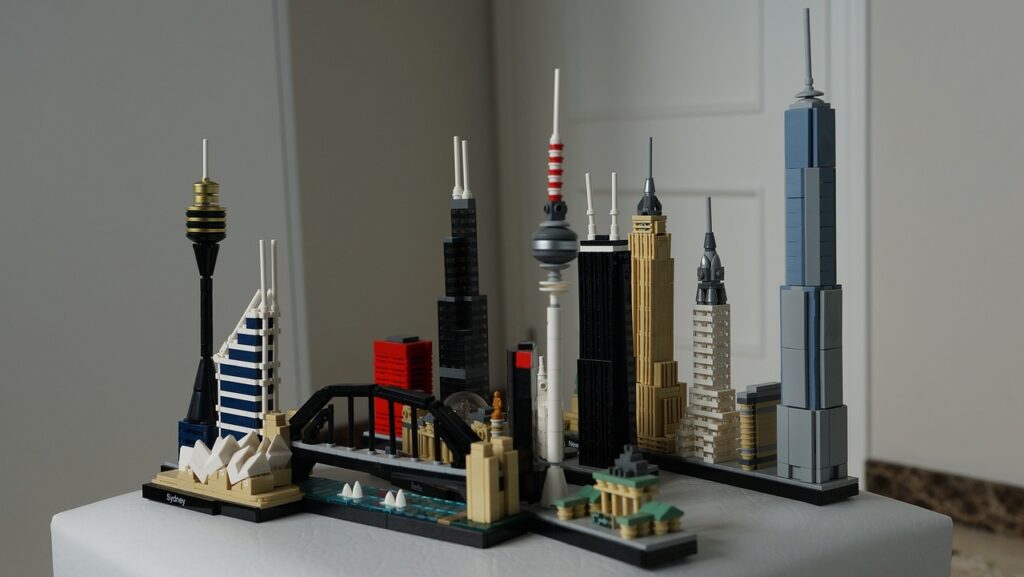What is Lego Architecture?
Lego Architecture is a series of Lego sets owned by LEGO Groups. It focuses on replicating the most famous architectural landmarks, buildings, and structures throughout the world. They first introduced Lego architecture in 2008. Since then, it has been a popular choice for kids to play with and build iconic building structures. [1] The sets contain pieces of Lego bricks with numbers on each piece. They are connected piece by piece to form a famous architectural building or city skyline on a microscale. The idea was to form a system for kids through which they can learn about different things, find pleasure, and be creative after finishing the construction work of the model.
These models or sets are designed precisely, considering all the relevant details and creating an exact replica of iconic landmarks throughout the world, such as the Burj Khalifa, Eiffel Tower, Taj Mahal, Empire State Building, Sydney Opera House, and some others.
History and Origin of LEGO Group
The LEGO Group is a Danish toy production company based in Billund, Denmark. They design and construct various toy sets or models made out of plastic. The sets are designed as pieces or Lego bricks that can be joined by interlocking blocks. That gives pleasure and enjoyment to kids and adults. It is a popular plaything for kids that teaches “learning and development through play.”.
LEGO Group was founded in 1932 by Ole Kirk Kristiansen and is still owned by the Kirk Kristiansen family. The current CEO of the company is Niels B. Christiansen, who is taking the company to new heights.
LEGO is a word that stands as an abbreviation of two Danish words, “leg godt,” which means “play well.” With this motto, they have come a long way over the past 92 years. Bringing smiles and joy to the faces of kids and adults.
To deep dive into the history of LEGO Group, click here…
Development of Lego Architecture
Adam Reed Tucker is credited as the inventor of LEGO Architecture, and all the designs of landmarked buildings were designed by him only. After completing his architecture in 1996, Adam planned to go with his passions and combine art with architecture. With this vision, he founded Brickstructures, Inc., and began to design models of different famous architectural landmarks. His work was noticed by the LEGO Group, and soon they approached him to work with them and build Lego sets under the Lego Architecture brand name. [2]
Architecture Series Set by Lego Architecture
Since the launch of LEGO Architecture in 2008, Lego has presented us with more than 40 LEGO Architecture sets that are available for adults as well as teenagers aged 13 and up. The models or sets are designed of world-famous landmarks from different eras, like Burj Khalifa, Falling Water, Villa Savoye, Robie House, the Big Ben, the Leaning Tower of Pisa, Taj Mahal, and so many others. The interesting thing to notice is that Lego Architecture was not the first product of Lego that was associated with architecture. Back in 1961, they introduced a product range called “Scale Model” to cope with people’s rising interest in designing their own houses.
The first construction set of Lego Architecture was released in 2009 under two series: the Architecture Series and the Landmark Series. These series focus on the detailed replicas of famous landmark buildings around the world. The Architecture series consists of models of Falling Water (21005) and the Guggenheim Museum (21004). While the Landmark series consists of models of Sears Tower (21000), John Hancock Center (21001), the Empire State Building (21002), and The Space Needle (21003). After the release of these sets, they became a popular choice for many adults and kids around the world. Seeing the demands and the popularity, Lego Architecture continued to release models of new landmark buildings.
As of June 2021, the biggest LEGO Architecture set as per the number of pieces available in the set is the Taj Mahal, Agra. [1] [2]
Characteristic of Lego Architecture
- Replicas of famous architectural landmarks around the world.
- Detailed work and realism.
- Minimalist design aesthetic with easy-to-use designs.
- Create products that teach learning and development.
- Use advanced building techniques for better designs.
Is Lego architecture has any benefits for Architecture Students?
Yes, Lego Architecture has several benefits for architecture students. Some of them are discussed below:
- Lego Architecture does not just offer models or sets of famous landmarked buildings from around the world. It also offers information about the history of buildings, about the architect, interesting facts, and statements about the buildings. The information is available on their website in the form of booklets. These booklets contain instructions about the model and other valuable information. You can click on the link to download those booklets of iconic buildings for FREE. Click here…
- While playing with the models of buildings, it teaches us to understand the architectural concepts, design principles, structure, scale, proportion, and details of a building. That is crucial for someone to understand because it recalls our architectural knowledge.
- Architects always find themselves in search of the most innovative ways to present their projects to the public and clients with elaborative models and virtual technologies. Perhaps the passion for buildings, design, and creation was triggered in them while they were playing around with the Lego bricks.
- Lego Architecture can offer students the opportunity to improve their ability to visualize and manipulate three-dimensional spaces. Lego bricks require problem-solving skills and an innovative mindset that teaches us creativity and innovation.
- While playing with Lego bricks, it can act as a therapeutic activity for us. Providing a break from architectural studies can create outlets for relaxation and stress relief. Allowing us to recharge and improve our creativity.












